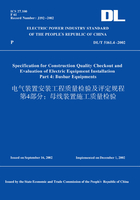
Foreword
Specification for construction quality checkout and evaluation of electric equipment installation is a series of standards for construction quality checkout,acceptance and evaluation of electric equipment installation.
The set of standards is comprised of the following 17 parts:
—Part 1:General rules;
—Part 2:High-voltage electric equipments;
—Part 3:Power transformers,oil-immersed type reactors and instrument transformers;
—Part 4:Busbar equipments;
—Part 5:Power cable lines;
—Part 6:Grounding devices;
—Part 7:Rotating electrical machines;
—Part 8:Panels,cabinets and secondary circuit wirings;
—Part 9:Batteries;
—Part 10:35kV and below over-head power line installation;
—Part 11:Elevator;
—Part 12:Low-voltage apparatus;
—Part 13:Power converter equipments;
—Part 14:Cranes;
—Part 15:Electric equipments in explosive or inflammable hazardous environment;
—Part 16:1kV and under feeder cable engineering;
—Part 17:Electric lighting devices.
Quality checkout of busbar equipments is the fourth part of this series of standards,which was prepared according to the document of Notice on Electric Power Industry Standard Preparation and Revision Project(Comprehensive Technology[1996]No.51)of 1996.
This standard is a tabular form of GBJ 149-1990 Electric equipment installation engineering code for construction and acceptance of busbar equipments,which is a professional standard applied to quality checkout of busbar equipments.
This part is proposed by and under the jurisdiction of China Electric Power Construction Research Institute.
Chief Development Organization:
China Electric Power Research Institute
Participating Development Organizations:
Northeast Electric Power Third Engineering Company
Jilin Electric Power Engineering Company
Shandong Electric Power First Engineering Company
Chief Drafting Staff:
Zhao Dianlin Chen Guiying Wei Guozhu Chen Fayu Zhang Anrong
Dong Gang Liu Zhiliang
China Electric Power Research Institute is responsible for the explanation of this standard.